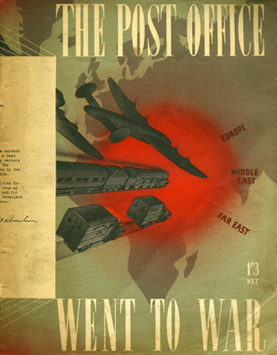 |
Faraday International Control Centre (ICC) opened on the 1st floor of the North Block on 4th May 1933 as a sleeve-control board of 121 positions; 93 Continental and 28 Radio working. The Radio Telephony Terminal (RTT) was situated on the same floor. |
| | EXIT | ICC History | Faraday Switchrooms: 2A | Linguist 3M & 4M | 4A & 5M | The End | | |
Faraday International Control Centre opened on the 1st floor of the North Block on 4th May 1933.
 |
The outbreak of war on 3rd September 1939 failed to disrupt the workings of The Post Office, but placed an incalculable strain upon the organisation and delivery of all its services... |
After the devastation of World War Two, the telephone network went through a period of growth as the demand for telephone service increased throughout the 1950s. The boom period of the 1960s meant there were waiting lists for telephones, and new developments, such as STD, made the service even more popular. ISD - International Subscriber Dialling was being tested, but in the meantime all overseas calls were still connected by an operator.
The Sixties
As the number of continental calls increased, measures were needed to separate French and English speaking traffic. This was achieved on City and Central exchanges (which in any case were housed in Faraday) by instructing subscribers to dial 104 for (predominantly) French speaking countries and 105 for English ones. This facility was later extended to the whole of the Director Area.
This division of languages was used in the switchroom designations:
- LFICC/E English speaking switchrooms or CX (Continental eXchange)
non-linguist
- LFICC/F French speaking switchrooms or CX (Continental eXchange)
linguist
In the 1970s, there were still many countries that could not be dialled directly by the subscriber. The majority of the manually connected calls were handled in Faraday ICCs (International Control Centres) using a combination of Demand & Delay working.
Demand Working with revertative signalling
These operators received calls from subscribers in the Provinces (not London) requesting an international call. The call was offered by the originating AMC operator. The Faraday operator then reverted the call (called back the subscriber) in order to set up the correct signalling path and to confirm that the calling party number was valid.
Delay Working
Demand calls not connected after 10 minutes were passed to the Delay positions where repeated attempts were made to connect, until the originating subscriber abandoned it. Subscribers wanting connections to countries with limited route availability were advised of the delay and called back when a circuit became vacant.
These were all located in the North Block:
- Continental
- Faraday Linguist 3M (3rd floor Main)
- Faraday Linguist 4M (4th floor Main)
- Faraday 4A (4th floor Annex)
- Faraday 5M (5th floor Main)
- Intercontinental
- Faraday 2A (2nd floor Annex)
| Faraday Linguist 3M & 4M (ICC/F) | |
 |
French was the preferred language on routes where English was not the first choice. |
Faraday 4A & 5M (ICC/E) The job of Switchboard Operator for the Post Office was well suited to school leavers, such as Helena Wojtczak, who recalls those exciting years in Faraday... |
|
 |
"I had a tenuous family connection with both the work, and the building. My sister had been an operator at Brighton local exchange in the late 60s and had told me what a good job it was. My father was a London chef, who had, between jobs in 1973, performed agency work. They had sent him to Faraday Building." |
| Faraday 2A | |
| Look in on 2A; meet the staff and managers... | |
 |
Faraday 2A (2nd floor Annex) was once a busy Intercontinental switchroom located within the North Block. |
In 1981 Switchroom 2A was part of a phased closure of Faraday ICCs. Some traffic moved to Wren House and the remainder to Wood Street. Brian Keeler ran the other LF/ICCs.
A press release in 1982 stated..." Operator traffic is being transferred to Wood Street 2 ICC from Faraday preparatory to the final closure of Faraday ICC units on September 20th."
Design, images and text compiled by ©
Light-Straw. Page last updated
24 May 2021.
All logos and
trade marks are the property of their respective owners and are used on
the Light Straw site(s) for review only. Students and researchers are
recommended to make their own independent enquiries as to the accuracy
of the information contained therein.